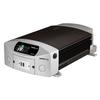Inverters convert the 12 or 24 volt DC energy stored in your batteries into household 115V AC electricity to run standard business and household appliances when shore power is not available, or when running a generator is impractical or inappropriate.
How they work
Inverters create household AC electricity like generators do, but they are preferable
for low wattage loads such as TVs, lights and computers, or variable demand
loads of up to 2,000 to 3,000 watts such as power tools. Inverters are also
good for running larger loads, such as microwave ovens, for short periods of
time. Inverters are silent, require virtually no maintenance, are easy to install
and reduce your hours of generator run time. Generators are better for heavy,
continuous loads like air conditioning, heating, and refrigeration that run
for extended time periods. The best electrical systems use an inverter/charger
combination unit and a generator, which runs during meals and other peak demand
times to supply energy and recharge the house batteries. During off-peak times,
the inverter continues to silently power smaller loads.
Can I run my air conditioner off my inverter?
Running a small 5000 BTU air conditioner for a couple hours is achievable, but
will draw heavily from your battery bank. An inverter with enough surge capacity
to start the air conditioner is also required We highly recommend professional
installation.
How much battery capacity is required?
Many appliances and electronics have their wattage on a back panel. If only
the amp rating is provided, use the following conversion formula: Volts x Amps
= Watts. A 7-amp microwave at the standard North American voltage of 115V will
need 805 watts of power to run. For each appliance, its wattage, multiplied
by hours run per day, divided by 10 will approximate the number of amp-hours
consumed from your batteries. For example, if you operate a 1000W heater for
an hour, you will consume 1000 watt-hours. 1000 watt-hours divided by 10 is
100 amp-hours of battery power consumed. Inverters must be supported by enough
battery capacity to make them useful without constantly having to recharge.
We recommend that you have at least 20% of your inverter’s rating in amp-hours
of battery capacity (a 1,000-watt inverter should have at least 200 amp-hours
of batteries to draw upon). This rule will let you run your inverter at full
power for one hour, or at half power for two hours, while consuming 50% of the
battery’s energy.
Where should the inverter be located?
We recommend installing a fixed-mount inverter no more than 10’ from the
battery bank, to avoid a voltage drop or oversized wires. Inverters are not
ignition protected, so are not safe for installation in gasoline engine compartments,
but can be installed in a diesel engine space. In general, you should pick a
location that is cool, dry, well ventilated and safe from explosive gasses produced
by batteries, engines and fuels.
How big should my inverter be?
Inverters range from tiny 100W models, good for laptops, to 4,000W models that
can run electric galleys and refrigeration systems. The size you select is governed
by the maximum power needed at one time. A computer (200W), TV/VCR (200W), and
microwave (800W) all running at the same time will need an inverter that delivers
more than 1200W of continuous power. Inverters typically fall into three categories:
Portable Inverters:
Portable Inverters generally connect to your DC electrical system using the common “cigarette lighter socket”. These DC sockets are often problematic due to poor contact or an insufficient gauge wire constricting the flow of current and contributing to DC voltage drop at the socket, but we digress. Portable Inverters are instant gratification products: just plug ‘em in, and start using their modest AC outputs (typically up to 300 watts). Ideal for laptops, small lights and tools. AC appliances are plugged into the front of the inverter. Portable inverters are also excellent for family trips in the minivan or SUV.Permanent-Mount Inverters:
Permanent-mount inverters (400 watts or more) are hardwired directly to the battery bank. Inverters in this range usually have receptacles for appliances to plug into, but do not integrate with your boat’s existing AC wiring. Some allow you to easily wire more receptacles to place in remote locations. Top of the line models include built-in transfer switches enabling full integration with existing AC wiring.Inverter/Chargers: (see previous category level "Battery Charger/Inverters")
Finally, larger inverter/chargers have outputs that rival small generators (2,000 to 4,000 watts) and include a powerful battery charger and associated battery monitors and remote controls. They should be professionally-installed because they become an integral part of your boat's electrical system and can rapidly replenish battery banks in the 400-800Ah range. We find that many trawler owners are drifting away from a large diesel generator, and are instead installing a large inverter/charger for their AC loads complemented by propane ranges and DC refrigeration systems.
What to look for
- Wave Form: Inverters today generally produce one of two types of AC power: Modified Sine Wave (MSW) or True Sine Wave (TSW). Affordable MSW inverters are the most popular type, and work well with common appliances you are likely to use. TSW inverters are more expensive, but will run all AC loads, and are best for stereos, computers and other sensitive electronics. Portable tool chargers, light dimmers, variable speed tools, plasma screens, home theater sound systems and certain other items may not perform as well with MSW.
- Remote Controls: Being able to control, monitor at-a-glance and program your inverter from inside the cabin is an important consideration, especially when the inverter is in a hard-to-reach place. Remote panels are a "must-have" for inverter chargers.
- Surge Capability: An inverter must be powerful enough to handle the "surge" or starting requirements of appliances. A 125 watt TV might need 625 watts for a few seconds when starting cold. If you are using an inverter without the adequate surge capability, it won't start the appliance.
- Power Factors and Generators: The charger in an inverter/charger presents
a large, inductive load for a small generator (under 8kW). Chargers with a
high "power factor" are desirable because they are less sensitive
to peak voltage and need less AC power. Xantrex recommends that a generator
be sized at 2.5 times the power draw of the charger.




























